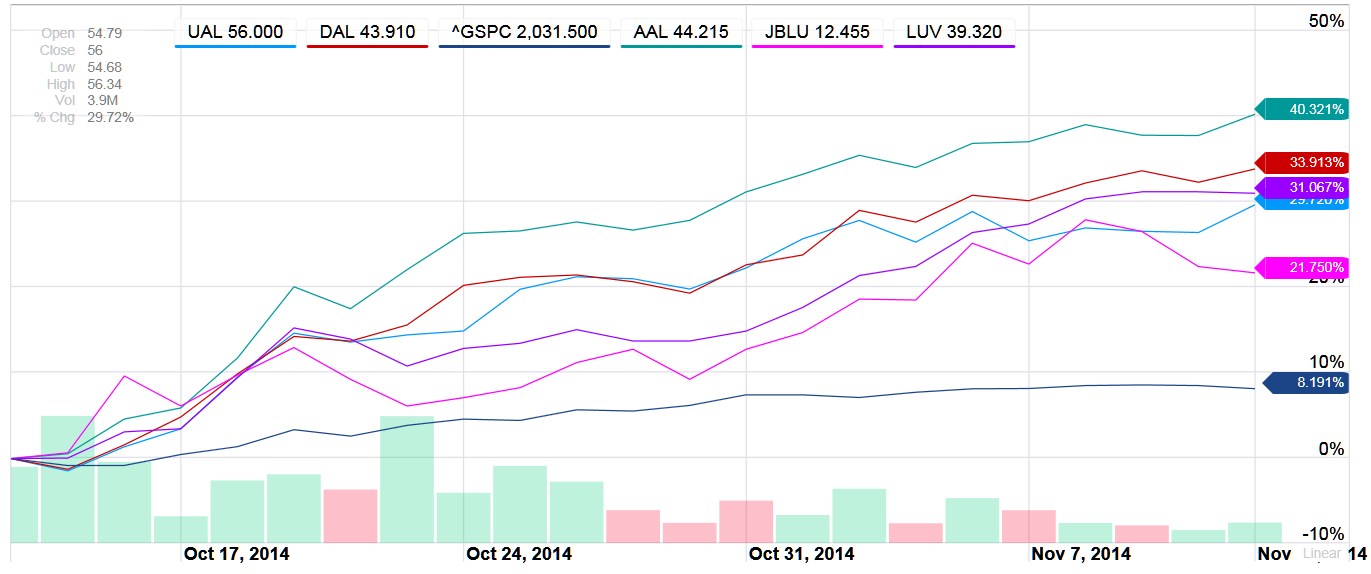The logic behind the massive gains in airliner shares is that as oil costs shrink, airliners should see their margins increase and earnings grow from there. That being said, the runs have been so strong over the last month or so that one question has to be asked — Have these airline stocks all run up too much?
Oil prices were reaching a 52-week highs in late-June and early July of 2014. This level was over the $100 barrel mark at $102.53. Since this time the price of oil had plummeted to a multiyear low of $74.02, and there seems to be no clear bottom in sight, as oil continues to slide lower.
24/7 Wall St. wanted to look at several issues here. First is how much these stock have risen from their lows in October and how that compares to a 52-week high as well. A Thomson Reuters consensus price target from analysts has been included along with basic trading information.
Another inclusion was the market cap of each stock, along with how analysts on Wall Street have the stock valued on a forward P/E ratio compared to 2015 earnings estimates. Lastly, a chart below from Yahoo! Finance shows just how much the one-month performance has been when compared to the broader S&P 500 Index.
American Airlines Group Inc. (NASDAQ: AAL) shares have reached a relative high on the year of $44.47, on November 11, up 58% from the low of $28.10 in the middle of October. Shares have recently been trading up about 2% at $44.38 in the last hour of trading. The company’s stock has a consensus analyst price target of $53.85 and a 52-week trading range of $21.45 to $44.88. It has a market cap of over $31 billion. American Airlines trades at only about 6-times expected 2015 earnings.
Delta Air Lines, Inc. (NYSE: DAL) shares were trading at 52-week highs Thursday morning at $44.41, up 47% from the lows in mid-October of $30.12. Shares were trading over 1% up at $44.15 in the last hour of trading. The company’s stock has a consensus analyst price target of $52.50 and a 52-week trading range of $26.40 to $44.41. It has a market cap of over $36 billion and Delta shares trade at almost 11-times expected 2015 earnings.
Southwest Airlines Co. (NYSE: LUV) shares reached a 52-week high on November 11, at $40.06 — up almost 41% from the relative low in mid-October of $28.40. Shares were trading up less than 1% at $39.45 in the last hour of trading on Thursday and Southwest shares have a consensus analyst price target of $42.81 and a 52-week trading range of $17.73 to $40.06. It has a market cap of about $26 billion. Southwest shares are valued at roughly 16-times expected 2015 earnings.
JetBlue Airways Corporation (NASDAQ: JBLU) shares reached a 52-week high on Tuesday of $13.23, this was up 41% from the relative low $9.38 on October 13. Shares were trading up about 0.5% at $12.58 in the last hour of trading. The company’s stock has a consensus analyst price target of $14.08 and a 52-week trading range of $7.61 to $13.23. It has a market cap of roughly $3 billion. JetBlue has a forward P/E ratio of about 12.5 versus 2015 earnings estimates.
United Continental Holdings, Inc. (NYSE: UAL) shares reached a 52-week high on November 4 of $56.90 this was up 44% from the relative low $39.46 on October 13. Shares were trading up 3% at $56.29 in the last hour of trading on Thursday. The company’s stock has a consensus analyst price target of $60.21 and a 52-week trading range of $36.10 to $56.90. It has a market cap of around $20 billion. Looking ahead to 2015, United Continental’s forward P/E ratio is 8.4 against 2015 estimates.
Looking forward, if oil prices continue to fall over this quarter, it would seem safe to expect these major airliners to get a boost in their earnings. Trying to call a top in a group of stocks based upon strong share performance in a short period of time on a major trend that has no known catalyst to end that trend is something that is incredibly hard to do. Still, gains of 20%, 30%, and more for an entire sector in a short period of time are far from normal.
Wall Street analysts still have upside projections compared to the current share prices. Also, these projected P/E ratios for 2015 could be even lower than today if the lower fuel costs add meaningfully to earnings in 2015.
Yahoo Finance
(Chris Lange - 24/ Wall St.)

No comments:
Post a Comment